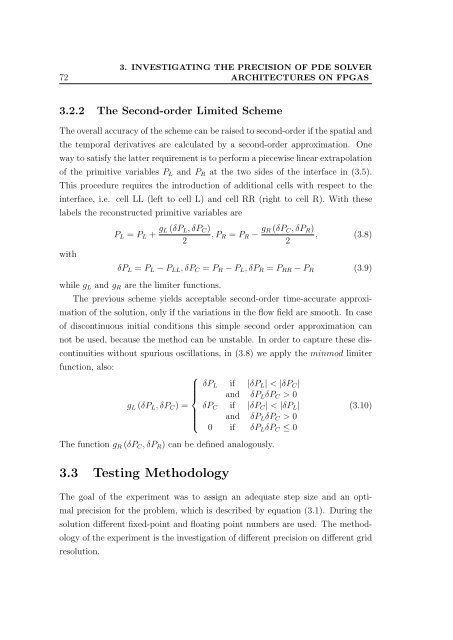PPKE ITK PhD and MPhil Thesis Classes
PPKE ITK PhD and MPhil Thesis Classes
PPKE ITK PhD and MPhil Thesis Classes
You also want an ePaper? Increase the reach of your titles
YUMPU automatically turns print PDFs into web optimized ePapers that Google loves.
72<br />
3. INVESTIGATING THE PRECISION OF PDE SOLVER<br />
ARCHITECTURES ON FPGAS<br />
3.2.2 The Second-order Limited Scheme<br />
The overall accuracy of the scheme can be raised to second-order if the spatial <strong>and</strong><br />
the temporal derivatives are calculated by a second-order approximation. One<br />
way to satisfy the latter requirement is to perform a piecewise linear extrapolation<br />
of the primitive variables P L <strong>and</strong> P R at the two sides of the interface in (3.5).<br />
This procedure requires the introduction of additional cells with respect to the<br />
interface, i.e. cell LL (left to cell L) <strong>and</strong> cell RR (right to cell R). With these<br />
labels the reconstructed primitive variables are<br />
with<br />
P L = P L + g L (δP L , δP C )<br />
2<br />
, P R = P R − g R (δP C , δP R )<br />
, (3.8)<br />
2<br />
δP L = P L − P LL , δP C = P R − P L , δP R = P RR − P R (3.9)<br />
while g L <strong>and</strong> g R are the limiter functions.<br />
The previous scheme yields acceptable second-order time-accurate approximation<br />
of the solution, only if the variations in the flow field are smooth. In case<br />
of discontinuous initial conditions this simple second order approximation can<br />
not be used, because the method can be unstable. In order to capture these discontinuities<br />
without spurious oscillations, in (3.8) we apply the minmod limiter<br />
function, also:<br />
⎧<br />
⎪⎨<br />
g L (δP L , δP C ) =<br />
⎪⎩<br />
δP L if |δP L | < |δP C |<br />
<strong>and</strong> δP L δP C > 0<br />
δP C if |δP C | < |δP L |<br />
<strong>and</strong> δP L δP C > 0<br />
0 if δP L δP C ≤ 0<br />
The function g R (δP C , δP R ) can be defined analogously.<br />
(3.10)<br />
3.3 Testing Methodology<br />
The goal of the experiment was to assign an adequate step size <strong>and</strong> an optimal<br />
precision for the problem, which is described by equation (3.1). During the<br />
solution different fixed-point <strong>and</strong> floating point numbers are used. The methodology<br />
of the experiment is the investigation of different precision on different grid<br />
resolution.






![optika tervezés [Kompatibilitási mód] - Ez itt...](https://img.yumpu.com/45881475/1/190x146/optika-tervezacs-kompatibilitasi-mad-ez-itt.jpg?quality=85)









